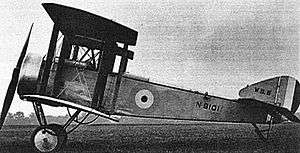Beardmore W.B.III
| WB.III | |
|---|---|
 | |
| Role | Carrier-based fighter |
| Manufacturer | William Beardmore and Company |
| First flight | 1917[1] |
| Primary user | Royal Navy |
| Number built | 100 |
| Developed from | Sopwith Pup |
The Beardmore WB.III was a British carrier-based fighter biplane of World War I. It was a development of the Sopwith Pup that Beardmore was then building under licence, but was specially adapted for shipboard use.
Design and development
It featured a redesigned wing cellule with no stagger and an extra set of struts inboard, facilitating folding for stowage, a modified fuselage that carried emergency floatation gear, and main undercarriage that could be folded for stowage on the WB.IIIF. Later examples, designated WB.IIID could jettison their undercarriage for safer water landings.
As many as one hundred were built, with small numbers deployed on various Royal Navy warships including the carriers HMS Furious, HMS Argus and seaplane tenders Nairana and Pegasus. Performance was less than the Sopwith Pup on which it had been based and it was largely superseded by the Sopwith 2F1 Ships Camel.
Operators
Specifications
Data from [1]
General characteristics
- Crew: 1
- Length: 20 ft 3 in (6.16 m)
- Wingspan: 25 ft (7.62 m)
- Height: 8 ft 1 in (2.47 m)
- Wing area: 243 sq ft (22.6 m2)
- Empty weight: 890 lb (400 kg)
- Loaded weight: 1,290 lb (585 kg)
- Powerplant: 1 × Le Rhône 9C, 80 hp (60 kW)
Performance
- Maximum speed: 103 mph (166 km/h)
- Service ceiling: 12,400 ft (3,780 m)
- Rate of climb: 534 ft/min (2.7 m/s)
- Endurance: 2 hours 45 min
Armament
- Guns: 1 × fixed, forward-firing .303 in Lewis gun
See also
- Related lists
References
Sources
| Wikimedia Commons has media related to Beardmore W.B.III. |
- Taylor, Michael J. H. (1989). Jane's Encyclopedia of Aviation. London: Studio Editions. p. 122.
- World Aircraft Information Files. London: Bright Star Publishing. pp. File 890 Sheet 04.